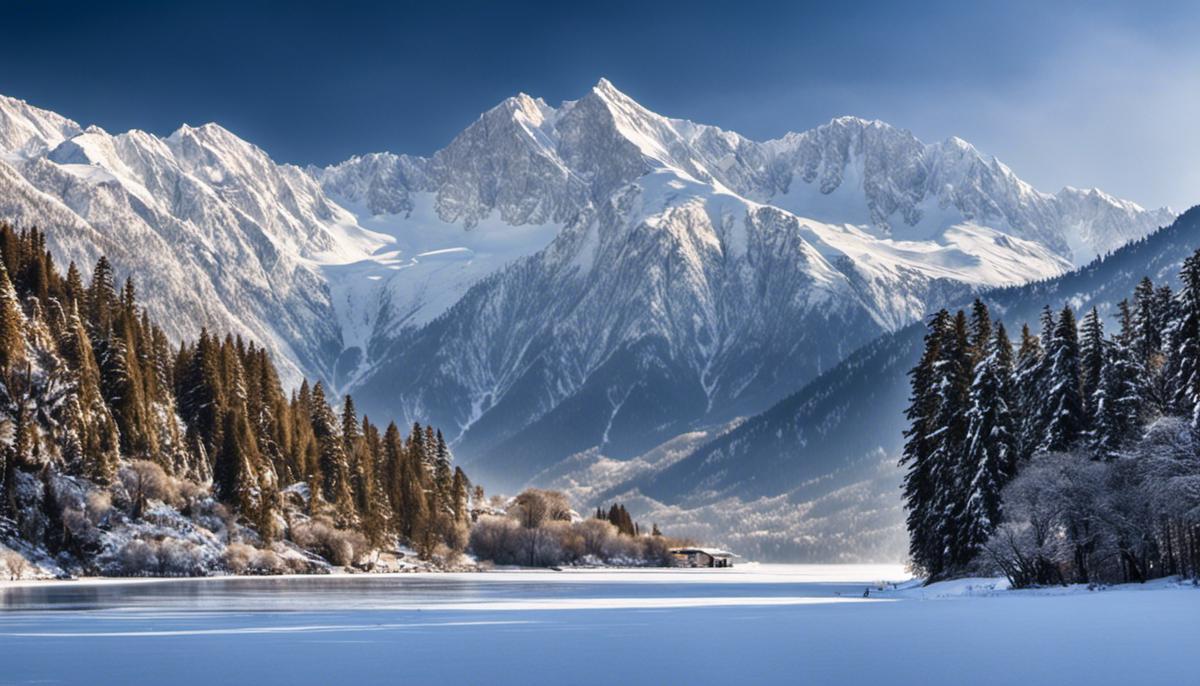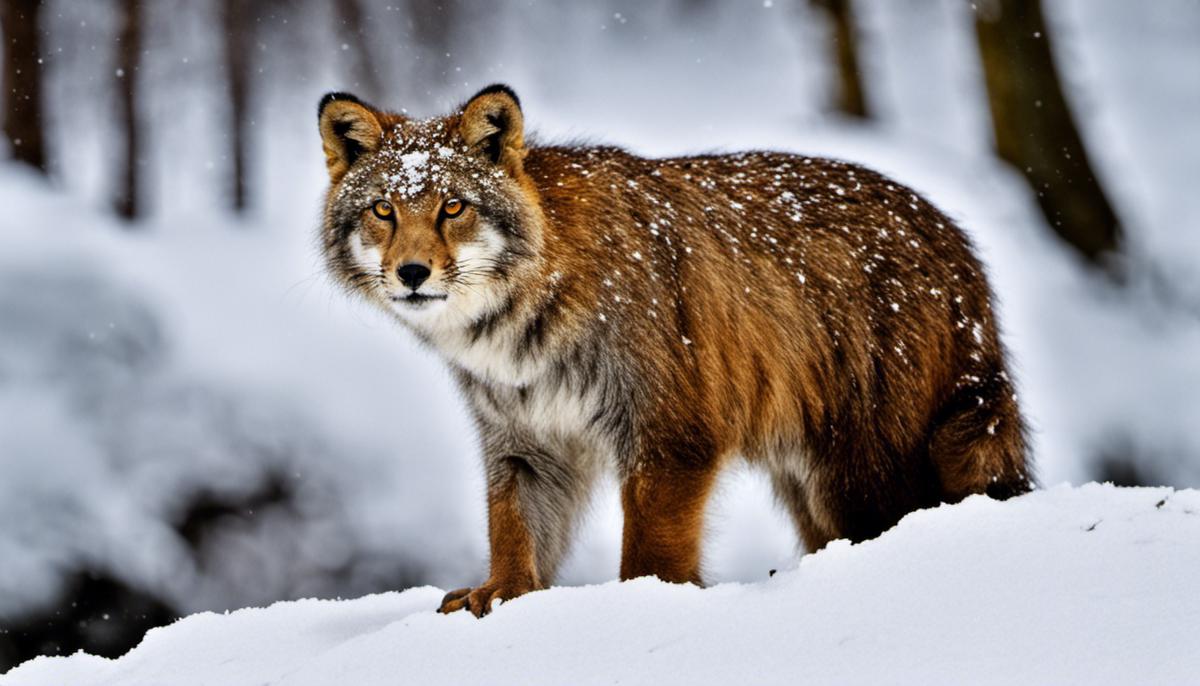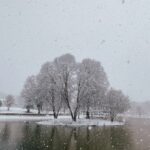The magic of winter unravels a new dimension of Kashmir – a transformative view of the locale that has filled countless poets, artists, and dreamers with awe. As temperatures plummet, a pristine quilt of snow cloaks the landscape, the morose skies contrast sharply against the snow-covered peaks as they glow ember-like during the day and resemble silver streaks under the twinkling night sky. From disruption in the humdrum of daily life to shaping the region’s festivities, winter influences the experiences of both inhabitants and tourists in the valley. This exploration delves into the details of the winter weather, natural grandeur, local culture infused with winter festivities, an array of winter sports, and the resilient fauna of this time.
Kashmir’s Winter Weather
Winter in Kashmir: A Gem of the Seasons
Winter season in Kashmir usually begins in December and extends until the end of February. During this time, the region transforms into a winter wonderland covered in a pristine layer of snow. The valley appears magical with its tall chinar and pine trees covered in white, while the lakes freeze, providing a different kind of beauty.
Average Temperatures and Snowfall
The average temperature in winter can drop to below freezing point. The average minimum temperature is around -2 degrees Celsius (around 28 degrees Fahrenheit), while it can dip to an extreme -8 degrees Celsius (about 17.6 degrees Fahrenheit) on colder nights. The day temperature can go up to 10 degrees Celsius (50 degrees Fahrenheit).
The region typically witnesses substantial snowfall during winter, especially in the higher reaches. And the amount of snowfall highly depends on the location and altitude. Srinagar, the summer capital of Jammu and Kashmir, receives about 24.6 inches (625 mm) of snow annually over 17 days of snowfall, with January being the snowiest month. Meanwhile, the ski-town Gulmarg receives a hefty 200-300 inches (508-762 mm) of snow annually.
Climate and Scenic Beauty
As winter settles in, the weather can be severe and intensely cold, mainly due to the heavy snowfall and chilling wind drafts. However, it is these harsh conditions that contribute to the region’s snow-capped mountains, frozen lakes, and frosty landscapes and transform Kashmir into a paradise on earth during winters. During this time, tourist sites like Gulmarg, Pahalgam, and Sonmarg take on a mesmerizing aura with their ethereal snow-covered beauty creating postcard-perfect winter landscapes.
Challenges Caused by Winter Weather
However, the winter wonderland also comes with its difficulties. The heavy snowfall can cause transportation disruptions by blocking roads and closing airports, isolating Kashmir from the rest of the world. It can also lead to power outages and disruption of other essential services. Plus, the excessive cold conditions can make it challenging for the people living in Kashmir, especially those in the rural areas where access to proper heating facilities may not be widespread.
Tourism during Winter
Despite the challenges, winter is also a major tourist season in Kashmir, thanks to winter sports like skiing, snowboarding, and snowshoeing in areas like Gulmarg and Pahalgam. Kashmir’s frozen lakes are also significant attractions for locals and tourists alike, offering unique experiences such as ice skating.
To put it succinctly, winters in Kashmir, though challenging, bring forth a panorama of tranquil and mesmerizing scenery alongside exhilarating sports activities. This season heralds a transformation – changing the region into an idyllic winter wonderland that lures tourists and adventure seekers from every corner of the world.

Landscapes and Sceneries During Winter
The Metamorphosis Brought by Kashmiri Winter
As the calendar marks the period from November to February, the verdant valley of Kashmir dons a breathtakingly beautiful white garb. This is the time when substantial snowfalls clothe the region, converting mountains, meadows, and orchards into a vast, white canvas, creating an ethereal winter scenery.
Snow-Covered Meadows and Mountains
In winter, the vast meadows of Kashmir are covered with thick snow, taking on an ethereal beauty accompanied by a tranquility that makes them irresistible to visitors and adventure enthusiasts. Gulmarg, Pahalgam, and Sonmarg are some regions that are spectacularly appealing due to their undulating snowy meadows, where skiing and snowboarding are popular activities.
The visibility of mountains like Harmukh, Nanga Parbat, and Nun Kun peaks prime with snow, against the blue winter sky, is an absolutely breathtaking view. The Pir Panjal and the Zanskar mountain ranges are particularly scenic, looking magnificent with their snow-clad peaks and slopes.
Frozen Lakes and Rivers
Lakes and rivers, an integral part of Kashmir’s landscape, freeze over in winter creating a fascinating spectacle. Frozen bodies of water, such as Dal Lake, are often dotted with locals walking or playing games on the icy surface. When frozen, these lakes and rivers offer interesting recreational activities like ice-skating or ice-hockey. Wular Lake, one of the largest freshwater lakes in Asia, turns into a gigantic ice field, where one can witness families enjoying sunny winter days on the ice.
Bare Apple Orchards
Winter renders the lush green orchards of Kashmir bare, as deciduous trees shed their leaves in anticipation of the cold. Kashmir, being a significant apple producing region, its orchards present a unique, monochrome charm during winter months when the trees are bare and the landscape is trimmed with snow.
Wildlife During Winter
Kashmir also is a home to several unique bird and animal species which reveal themselves during winter. The Dachigam National Park is particularly active, with the Hangul or Kashmir stag being a prominent sight. Among the bird species, the Black-necked Crane and the Himalayan Monal make an iridescent display against the white backdrop.
In Conclusion
Winter in Kashmir brings forth an enchanting visual spectacle as the region transforms into a wonderland blanketed in serene, pristine white snow. The shift in climate and transitions in the vegetation, noticeable in the stark bare orchards and snow-clad meadows, transform Kashmir into an awe-inspiring winter destination.

Photo by thebeardbe on Unsplash
Winter Festivities and Local Culture
The Charm of Winter in Kashmir: A Fusion of Culture and Tradition
Winter in Kashmir paints a magnificent panorama of snow-covered scenery, an ethereal beauty that has rightly earned the region the moniker of the “Switzerland of the East.” Yet, beyond the captivating vistas, Kashmir during winter bursts into life with unique local cultural customs alongside traditional festivities and events. This spirit of celebration deeply enriches the winter experience for both locals and tourists.
Traditional Revelries: Shikara festival
Shikara festival is one of the prime attractions of the winter season in Kashmir. While Shikaras, the intricately hand-carved wooden boats, are a significant part of the everyday life of people in this region, during the festival they become symbols of cultural expression and traditional celebration. Shikara owners elaborate their boats with vibrant hues and decorations, creating a picturesque scene on Dal Lake. The festival usually comprises of boat races where Shikara owners compete, amidst folk music and dance performances that complement the festive atmosphere.
Multitude of Celebrations: Winter Carnival
Another major event during the winter in Kashmir is the Winter Carnival, a vibrant and enthralling celebration that includes activities like snow skiing, ice-skating, ice hockey, and much more. Locals enthusiastically participate in these activities, which are also open to visitors giving them a chance to immerse themselves in the local culture and tradition. Associated with this Winter Carnival are cultural evenings where traditional music and dance performances take place, showcasing the rich and diverse heritage of the region.
Religious Harmony: Christmas in Kashmir
Despite being a predominantly Muslim state, Christmas in Kashmir is celebrated with equal zeal and enthusiasm, upholding the virtues of peace and brotherhood. During winter, the region’s churches, including the Holy Family Catholic Church in Srinagar, are adorned with lights, stars, and bells. Midnight masses are held on Christmas eve, and the day itself is marked with feasting and exchanging of presents. This celebration is a true depiction of religious harmony, with people of all faiths participating in Christmas festivities.
Unique Winter Activities
In addition to the aforementioned events, winter in Kashmir is also a time for unique activities like snowball fighting and building snowmen, which are deeply ingrained in local culture. The Harissa, a traditional meat dish, is a winter food staple, keeping the locals warm in freezing temperatures. These traditions and activities enrich the experience of winter in Kashmir and imbue it with a distinct cultural significance.
Winter in Kashmir goes beyond the captivating visuals of snowy landscapes; it extends to an enriching connection with the local culture and traditions. The widely shared sense of community, coupled with fascinating cultural practices, provides one with a comprehensive understanding of life in this part of the world.

Winter Sports and Activities
Snow-filled Activities in Kashmir
Along with its reputation for unrivalled scenic beauty, Kashmir also presents an array of winter sports and activities. The region’s lush hills and awe-inspiring valleys transform into pristine snow-clad terrains when winter arrives, serving as the perfect playground for thrill-seekers and adventure enthusiasts.
Skiing and Snowboarding in Kashmir
Skiing and snowboarding are some of the most popular winter sports tourists and locals delve into in Kashmir. Gulmarg, a scenic town nestled in the Pir Panjal Range of the Western Himalayas, is a prime spot for both of these winter endeavours. It has one of the highest gondolas in the world and boasts a variety of ski slopes, catering to beginners and professionals alike, making it a perfect spot for snowboarding and skiing enthusiasts. The Ski Club of India, established in Gulmarg, offers ski equipment and training for starters.
Snow Trekking in Kashmir
For the trekking enthusiasts, the winter season in Kashmir offers a magical experience. Various trekking routes, including the Aru Valley and Tarsar Marsar, offer a unique trekking experience during the winters. The snow-covered mountain trails with azure sky backdrop make for a tranquil and unmatched experience. The treks along these routes range from moderate to difficult with some needing experienced guides and thorough preparation.
Ice Skating in Kashmir
Ice skating is another popular winter activity in the region, with locals and tourists enjoying the thrill of gliding on the frozen surfaces. While professional ice-skating facilities aren’t widely available in Kashmir, numerous frozen water bodies during winter offer a natural ice-skating rink. For example, local children often enjoy ice skating on frozen ponds and lakes in the region.
Safety Measures
While these activities offer fun and adventure, it is essential to exercise caution and prioritize safety. Tourists should be prepared with suitable winter gear and adhere to all safety protocols while resembling activities. Additionally, availing services of local guides or tour operators can ensure a safer and more enjoyable experience.
Experiencing Winter in Kashmir
Winter in Kashmir is a unique blend of chilling beauty and exhilarating adventures. The tranquil region is transformed by seasonal snowfall, offering a myriad of outdoor activities and sports for thrill-seekers. The snowy landscapes not only enhance Kashmir’s inherent charm but also present a range of possibilities for fun-filled winter experiences.

Winter Wildlife in Kashmir
Exploring the Wildlife of Kashmir’s Winter Wilderness
Kashmir is cradled within the majestic Himalayan and Pir Panjal ranges. Come winter, these snow-kissed landscapes metamorphose into an enchanting wonderland brimming with diverse wildlife. Amidst the frosty woods, thousands of unique flora and fauna species thrive, reflecting a remarkable biodiversity that endures the strenuous winter conditions.
Animal Behavior During Harsh Winters
One of the most iconic animals distinct to this region is the hangul, or Kashmir stag, a subspecies of red deer characterized by its large size. To survive the chilling winter, hanguls rely on fat reserves they build up during the warmer months while grazing in the forests and the high-altitude meadows. Conversely, other creatures such as the Himalayan brown bear adopt hibernation as a survival tactic during the colder months. Hibernation involves long periods of sleep, slowing down their metabolic functions, thus conservatively using their stored body fats.
Many bird species, such as the Lammergeier vulture, the Himalayan griffon vulture, and the bearded vulture, brave the weather by adapting their behavior and diet against the freezing temperatures. These avian inhabitants rely on their ability to regulate their body temperature and often puff up their feathers for additional warmth.
Protected Areas & Sanctuaries in Winter
Kashmir is home to a range of protected areas specially designated to conserve its diverse flora and fauna. The Dachigam National Park, which means “ten villages,” is one such sanctuary and a prominent wildlife reserve. During the harsh winters, the park sees a considerable decline in human activity, offering a tranquil refuge for the wildlife to thrive.
Covered in shimmering snow, Gulmarg Wildlife Sanctuary is another significant protected area in the region. With reduced human disturbances during winter, the sanctuary serves as a wintering ground for numerous species like the musk deer and the Himalayan black bear.
Adaptation Strategies among Kashmir’s Wildlife
Kashmir’s wildlife has evolved over time to adapt to the extreme winters. Animals have developed thick fur coats and layers of fat to insulate them from freezing temperatures. They have also adapted behavior changes such as migration to lower altitudes, hibernation or torpor, or changes in feeding habits.
Bird species, too, have evolved unique survival strategies. Some species change their plumage to snowy white for winter camouflage. Others store food or even change their diet, consuming high-fat foods to store fat reserves for the winter. Some birds huddle for warmth sharing body heat with each other.
Kashmir’s wildlife is an intricate tapestry woven with resilience, adaptation, and survival. Even under the heavy snow and icy winds of winter, it thrives and thrashes, epitomizing the very spirit of life in alterity. Despite the challenges of harsh weather, wildlife in the snow-capped forests of Kashmir paints a vivid picture of thriving biodiversity.

Winter in Kashmir paints the region in a unique hue, a captivating blend of challenges and charms. The beautiful landscapes, draped in snow, are not only a feast to the eyes but also a gateway to adventure for winter sports enthusiasts. The season also unravels the heartwarming traditions of the locals, an emblem of their indomitable spirit in face of the harshest winters. In the heart of this frostiness, the wildlife persists, finding ways to adapt and survive in the thick blankets of snow, their presence a testament to the coexistence of beauty and resilience in these wintry landscapes. As winter in Kashmir ebbs away, it leaves fragments of memories ensconced in snowflakes- a white paradise graced by the elegance of nature, rich traditions, and the pulsating thrills of winter activities.
Writio: The ultimate AI content writer and rank tracker. This page was skillfully crafted by Writio.




